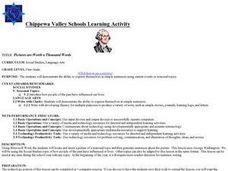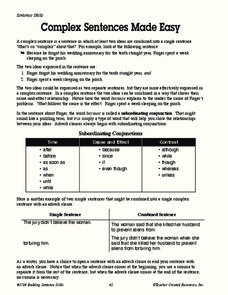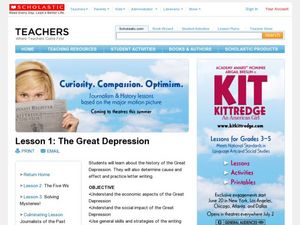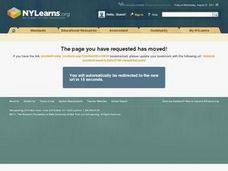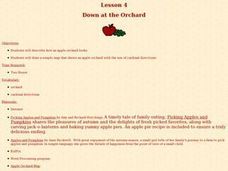Curated OER
Pictures Are Worth A Thousand Words
First graders write simple sentences based on historical figures they find in pictures. In this simple sentences lesson plan, 1st graders search for pictures in Microsoft Word and write simple sentences about them. These pictures and...
Curated OER
The Cuneiform Writing System in Ancient Mesopotamia: Emergence and Evolution
Students research the parallel development and complexity of writing and civilization in ancient Mesopotamia. In this ancient Mesopotamia lesson, students analyze the Cuneiform writing system in ancient Mesopotamia and how the...
Teacher Created Resources
Complex Sentences Made Easy
Support scholars' ability to write complex sentences with a two-page worksheet designed to inform and reinforce. Here, learners obtain a brief overview of what a complex sentence is and how one is made; then apply their new-found...
Curated OER
The Great Depression: Lesson 1
Students recognize how the causes of the Great Depression affected people and their jobs. In this Great Depression lesson, students understand that most of the time news only came from newspapers. Students write a letter as though they...
Curated OER
Simple Past and Present Verbs
In this grammar activity, students rewrite a paragraph and change all the underlined verbs from simple past tenses to present tenses.
Curated OER
Asking For Directions
Students draw a map of their surrounding area using appropriate landmarks and identifying characteristics. Students ask for and give directions to locations found on their maps to their partner. This lesson is intended for students...
Center for Innovation in Mathematics Teaching
Vectors
Investigate vectors and learn how to use them. Explore why size and direction, as well as knowing speed and distance, are important components of the vector problems you are trying to solve. This is an extensive lesson which includes six...
Curated OER
Sequences
In these math worksheets, students will complete 3 pages of sequencing work. The first page is Simple Sequences (17 problems). The second page is Harder Sequences (18 problems). The third page is Fibonacci Sequence work (9 problems).
Curated OER
Como Se Hace...?
Learners work in groups to give step-by-step instructions to the rest of the class about an activity of interest. They write presentation proposals, research the activity and then draft and edit a presentation. Students present their...
Curated OER
Ordinal Numbers
Introduce ordinal numbers with this simple teaching tool. Young mathematicians trace numbers from 1 to 5. Then they circle the object in a row of 5 that represents the numerical place of the number they just traced. Example: Students...
Hawaiʻi State Department of Education
Characters from a Box
Character analysis is a skill we use when we read literary works or want to write a good story. Learners will use drama to practice character analysis while focusing on the details that make characters act the way they do. They'll each...
Curated OER
Sentence Combining
Avoid short, choppy sentences in your class's writing by focusing on sentence structures. The first page in this two-page packet shows your class how to combine sentences using conjunctions, a list, an appositive, or compound predicate....
Curated OER
The Simple Future Tense
In this simple future tense worksheet, students read the rules for forming this tense. They write the correct form of the simple future tense using "will" in 7 sentences. They do the same using "going" in the next 7 sentences. They write...
Curated OER
Giving and Taking Directions
Learners identify the difference between commands and a declarative sentence. They complete a diagram with verbs, prepositions and numbers. They follow directions using a map and give directions to another location.
Curated OER
Giving and Taking Directions (Middle School)
Students describe the difference between a declarative sentence and a command. They complete a diagram verbs, prepositions and numbers. They follow directions on a map and create directions of their own to another location.
Curated OER
Mirror Writing
In this mirror writing worksheet, students follow the directions to decide which alphabet letters are symmetrical. Students use a mirror and a white light as they work in partners to trace simple shapes.
Curated OER
Factual Writing: Instructions
Students write step-by-step instructions for tasks. In this factual writing lesson, students complete an online activity. Each group also writes directions for completing a task. A worksheet is available for more practice.
Curated OER
How Well Do You Follow Directions?
Students complete an activity by following directions. They discuss the results of the activity and take a quiz. They repeat this lesson once a month.
Curated OER
Alfie's Bad Week - Past Simple Verbs
In this ELL grammar worksheet, students work with the past simple negative verb forms. They rewrite a to do list using the new verbs and compare the lists verbally with a partner. They complete 8 fill in the blank answers.
Curated OER
Present and Past Simple Passive
In this present and past simple worksheet, students choose the correct words to complete sentences, rewrite sentences, rewrite questions, and more. Students complete 5 activities.
Curated OER
Simple Research
Students conduct a simple research project using the internet as a source. They are shown how to narrow down a subject area to facilitate the search process. Students are shown the various search engines and how to tell whether a source...
Curated OER
Down at the Orchard
First graders examine what an apple orchard looks like and work with cardinal directions. In this apple orchard and direction instructional activity, 1st graders listen to Anne Rockwell's, Apples and Pumpkins, and Amy and Richard...
Curated OER
Conventions: Quotation Marks
Fifth graders determine the difference between indirect and direct quotations. For this grammar lesson, 5th graders recognize that direct quotations have quotation marks and understand what the rules are for using quotation marks.
Curated OER
Inclined Plane and Pulley
Learners describe how inclined plane and pulleys make work easier. In this physics lesson, students calculate work done and mechanical advantage of both simple machines. They collect data from the experiment and construct graphs.


